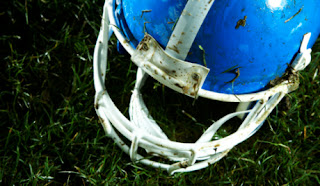 |
President Barack Obama said he'd have to think long and hard before permitting a son to play football. Even the National Football League (NFL) Commissioner, Roger Goodell, has been known to deflect the question from time to time. Bernard Pollard, Baltimore Ravens' safety, is doubtful that the NFL will even exist in 30 years. And then there's Ann McKee, Co-director of the Center for the Study of Traumatic Encephalopathy (CSTE); a woman who has the heartbreaking job of working with the widows and family members of deceased athletes and military personnel. Some of these men and women, who decided to donate their body to this specific research, will be diagnosed via autopsy with Chronic Traumatic Encephalopathy (CTE). McKee has also recently been framed as "the woman trying to destroy football."
In reality, McKee and her team at the CSTE are working to learn more about, and eventually destroy, tau, an abnormal and invasive protein which causes horrific symptoms such as depression and dementia. So far, the research center has accepted brain and spinal cord donations from two military personnel, eight hockey players, five boxers and wrestlers, one soccer player and two amateur athletes. The rest of the donations publicized by the CSTE have come from football. A bevy of players from varying leagues and levels, including: one youth athlete; six high school; 11 student-athletes; and an astounding 37 professional football players.
As of the beginning of this year, 32 NFL players were diagnosed postmortem as victims of CTE at research centers across the country- and those were just the bodies that were donated for testing for the silent killer. This astounding number includes the beloved Tiania Baul "Junior" Seau. The death of this linebacker, a man renowned for his joyful nature, seemed to hit home for many players and fans. With more frequent discussion of concussions and their long-lasting side effects, as well as rule changes and fines for hard hits, some fans (or former fans) have been complaining of the loss of the sport's masculine nature. What is the future of football?
Some say fans will get fed up with the drastic change of the game. Others, like Pollard, are doubtful that the sport will continue at all. Then there are fans like myself; fans who feel that the sport isn't going anywhere. Too many people love the game and more importantly, the lifestyle, that football warrants. Beyond that, the positive effects that all levels of the sport have on their local economy is reason enough to rapidly curtail any efforts to stop Amerca's new favorite pastime.
According to Business Insider, the NFL's revenue reached over nine billion this past year. A $500 million increase from 2010-2011. This enormous number does not include the unfathomable amount of others ways football keeps the economy going.
Stadiums employ people, teams employ front office staff, doctors, trainers, cheerleaders, coaches, psychologists, etc. A team's entire home city benefits from a home football game. Then there's the lifestyle that makes football well, football. The beer and burgers of tailgating, jerseys and memorabilia, hotel rooms and bar tabs, the list never ends. NCAA teams are no different: D1 football teams are semi-relied on by their home universities. Some high school seniors base their college choice on the environment that their school provides them with on Saturdays during the fall and winter months. The sport of football simply generates too much revenue for it to just disappear.
CTE has been known to effect boxers since the 1920's, but boxing still exists. The United Rules of Mixed Martial Arts has strict rules forbidding kicking or kneeing the head of a grounded fighter, rules similar to the NFL's Unnecessary Roughness calls in the protection of a defenseless player. Despite these rules, athletes of all sports are still suffering from symptoms of CTE.
Some critics of CTE's existence, say that the depression and suicide all too common among retired players is due to the sudden halt of the famed football lifestyle. When playing the sport, professional athletes have trainers and doctors at their beck and call. Diet and exercise plans are laid out for them and their days are filled with working out, reviewing plays and watching film with the coveted Super Bowl trophy not far from their minds.When retirement comes, that lifestyle and career that served as the building blocks of of self-identity disappear. Granted, some players will continue making appearances, writing books and contributing to talk shows as analysts. Others will never grace the cover of the sports section again.
The NFL has been working diligently to improve player protection and strengthen research efforts across the county. Just this past September, the NFL committed to a $30 million donation to the Foundation for the National Institutes of Health. It was the League's largest philanthropic donation and it all was specified to fund research on diseases and health issues deemed all too common amongst professional athletes, including CTE. The NFL's newest branch, NFL Evolution, is making strides in publicizing what the League is doing in order to save its players.
Between the NFL's dedication to funding research, the love of the football lifestyle and our nation's economic reliance on the game, we don't have to worry - football's here to stay.
No comments:
Post a Comment